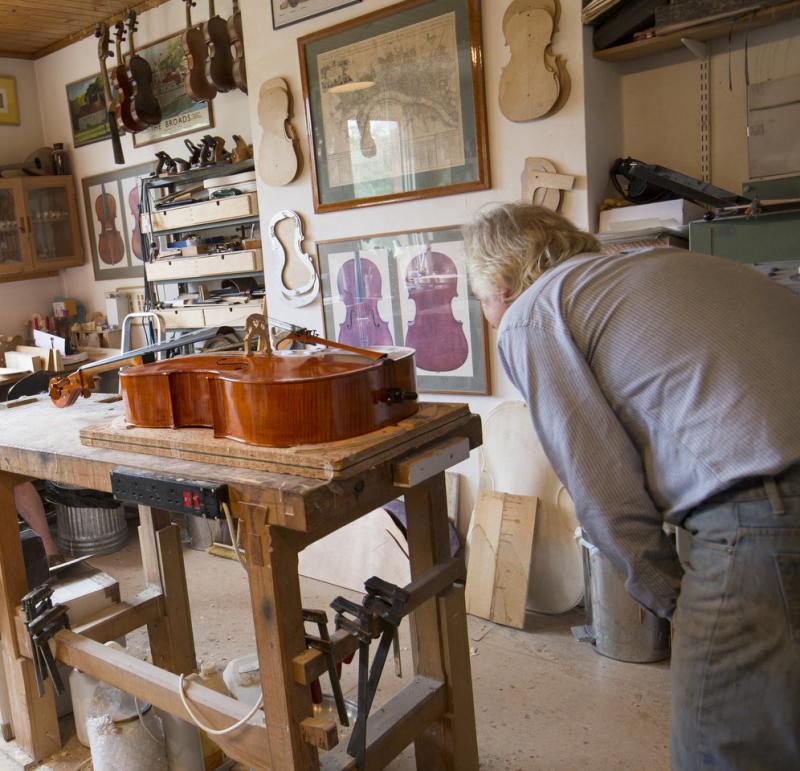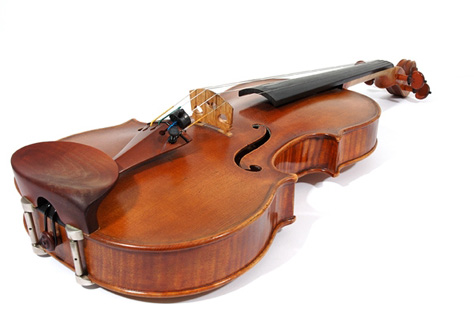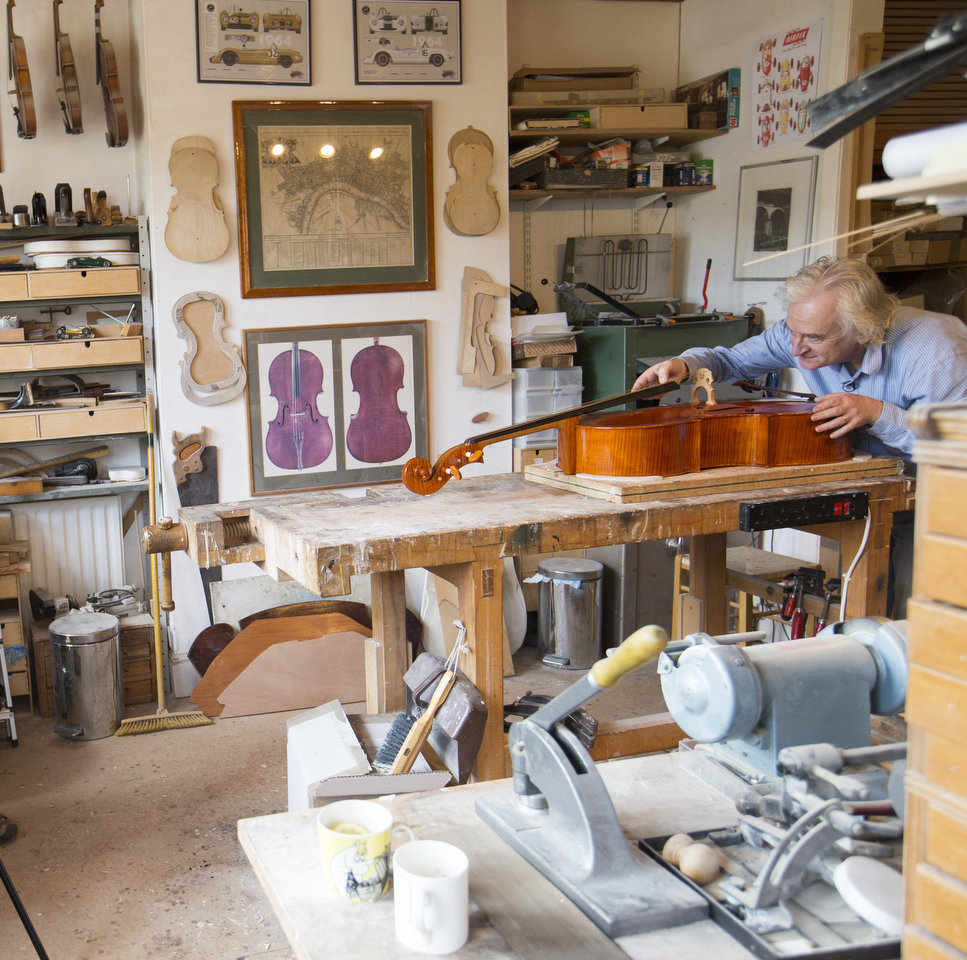We Made It: Violin Maker John Dilworth | reviews, news & interviews
We Made It: Violin Maker John Dilworth
We Made It: Violin Maker John Dilworth
With historical instruments in dwindling supply, meet a craftsman using historical techniques

How much would a Stradivarius or a Guarneri violin set you back? Hundreds of thousands of pounds? These days it’s more like millions – many millions. With the value of the finite collection of 17th- and 18th-century instruments only rising every year, and their appeal as investments increasing proportionally, it’s a rare musician indeed who can afford to play a historical violin of this quality.
But what looks at first glance like a crisis is actually the catalyst for an unprecedented boom in instrument-making. No longer playing second fiddle to their elder counterparts, contemporary violins, violas and cellos are more and more in demand, dominating orchestras and even competing for the attention of international soloists. Twickenham-based craftsman John Dilworth has been making and restoring stringed instruments for almost 40 years. During this time he has seen the art of instrument-making change from an isolated and secretive one to a newly lively and exciting field.
ALEXANDRA COGHLAN: How did you get into violin-making?
JOHN DILWORTH: As a frustrated musician! I was inspired, along with a lot of colleagues, by the folk-music movement of the early 1970s – that’s when I first got interested in the violin. I was about 18 at the time, certainly too old to take up the violin with any hope of becoming a professional classical player, but I was fascinated by the instrument and its history; there’s so much literature and romance.
How does violin-making differ from cabinetry and other wood-working crafts?
A lot of people in the trade have said to me that they started off as cabinet-makers, but always looked on violin-making as the zenith of the craft – it’s a particularly refined and admired aspect of that trade. I didn’t have any proper woodworking training myself, so I just learned the skills on the job.
 How many violins would you make in a year?
How many violins would you make in a year?
I make about six a year on average, which includes cellos – those take up a much larger chunk of time. Each violin (a Dilworth violin, pictured left) takes about a month to make, from start to finish.
Do all violin-makers make violas and cellos too? What about double basses?
Yes, we all make violas and cellos as well. Bass-makers however tend to be specialists. Historically basses don’t, strictly speaking, belong to the violin family; they are residual viols and have different tuning and construction. There are violin-makers who have made a bass for a dare, but I’ve never done one!
Where do you source wood from?
When I started out everything was rather more uncertain – we were having to make our own tools and hunt for wood. But in recent years it has become a much more sophisticated trade. The spruce used to make instruments is very specific – it has to come from high Alpine forests. There are valleys in the Alps where the wood is harvested specifically for instrument-making and has been since the 15th century – it’s the only stuff that really works. The finest maple wood comes from the Balkans.
 Talk me through process of making a violin.
Talk me through process of making a violin.
You start off with a slab of maple wood and a slab of spruce – the back, sides and the neck scroll are all made from maple and the top is the resonant spruce. Generally the back and front are carved from these solid pieces, which start off as 25mm planks; then you carve it down to that nice curved arch shape. Getting that curve right determines how it is going to speak and what quality of sound it is going to have.
Then you turn it upside down and hollow it out. That’s done either through feel or, these days, with sophisticated computer testing systems, though I don’t use any of that. It’s another critical stage in determining the kind of sound you want to get from the instrument. The sides are made from thin strips of maple. You cut them off the back if you can, so it all matches. Those are bent around a mould and then it’s all assembled. You make the neck out of a separate piece of maple, and that’s carved. Once the body – the sound-box as it is prosaically called – is all finished, you fit the neck in with a mortise at the top and then you varnish it. (John Dilworth puts the finishing touches to a cello, above)
Is it a process that's changed much since Stradivarius was working?
The problem we have as new makers is unique: the old instruments are so highly prized that we're trapped in trying to replicate those – that’s what people want. If you can’t afford to buy a Stradivarius then you want to buy the closest thing to it. Most of my work and that of my colleagues is doing our best to replicate precisely what Stradivarius did (Dilworth's historical techniques are used to construct a cello, below). We work out exactly what materials and techniques were available to him, and how he himself would have done it in 1700. In actual fact there’s not much that you can change. Even the computer-equipped workshops are basically using the same techniques and materials that Stradivarius did. Some people do manage to add in a bit of mechanisation here and there, but it is frowned on.
 So if it’s a craft that can be mechanised, why do craftsmen still work in this field? What do you bring to instruments that machines can’t or don’t?
So if it’s a craft that can be mechanised, why do craftsmen still work in this field? What do you bring to instruments that machines can’t or don’t?
The idea of making instruments by hand is to tailor them to what the player wants. Not all players are going to stand up as soloists in front of a huge symphony orchestra. They might play in a quartet, an orchestra or a chamber orchestra, and want a violin that responds to the needs of these different roles.
Clients tell me what context they play in, what sound they like. We have quite a long consultation, and then I make an instrument that suits that particular application. The idea and the hope with these new instruments is that they will develop their voice over the years. There’s a lot of input from the player in developing the sound. They want something that they can influence, that they can take from the cradle and develop into their own personal voice, which is not something you hope to do with an off-the-peg, factory-made instrument.
What’s the relationship like between instrument-makers – do you all share tips and techniques, or is it more secretive?
Back when I started out people were very secretive and protective of their methods. Now people do share information much more freely, pooling our knowledge rather than everyone trying to invent everything from scratch themselves. I think we all feel that we’re on the cusp of a new period in instrument-making. A lot of work has gone into rediscovering old methods and techniques and we’ve got so many resources now to help us with research.
Recent articles have claimed that, in a blind listening test, people couldn’t tell the difference between an 18th-century violin and a good contemporary one. Do you agree?
No. I disagree absolutely. I’ve always been a restorer as well as a maker, and I’ve worked all my career with both old and new instruments. I’ve had soloists in my front room playing on their Strad, and in those close quarters there is absolutely no comparison. There is no way any of my violins will ever match that, and I don’t know that any of my colleagues are that exceptional either. I’ve seen and heard most of their work and it’s marvellous, but a great old violin just has many more dimensions in its sound.
It’s very sad that instruments have become such a popular investment. Strads, and the secondary and even tertiary ranks of great instruments, have gone beyond the price any musicians can afford. For us makers, though, it’s a wonderful opportunity to step up.
Explore topics
Share this article
The future of Arts Journalism
You can stop theartsdesk.com closing!
We urgently need financing to survive. Our fundraising drive has thus far raised £49,000 but we need to reach £100,000 or we will be forced to close. Please contribute here: https://gofund.me/c3f6033d
And if you can forward this information to anyone who might assist, we’d be grateful.

Subscribe to theartsdesk.com
Thank you for continuing to read our work on theartsdesk.com. For unlimited access to every article in its entirety, including our archive of more than 15,000 pieces, we're asking for £5 per month or £40 per year. We feel it's a very good deal, and hope you do too.
To take a subscription now simply click here.
And if you're looking for that extra gift for a friend or family member, why not treat them to a theartsdesk.com gift subscription?
more We made it
 We Made It: Guitar Maker Brian Cohen
The incredible one-man string band
We Made It: Guitar Maker Brian Cohen
The incredible one-man string band
 We Made It: Basket-maker Lois Walpole
Weaving works of art from 'ghost gear' and the detritus of consumerism
We Made It: Basket-maker Lois Walpole
Weaving works of art from 'ghost gear' and the detritus of consumerism
 We Made It: Horn Maker Tom Fisher
Bespoke horns, handcrafted in a Derbyshire cellar
We Made It: Horn Maker Tom Fisher
Bespoke horns, handcrafted in a Derbyshire cellar
 We Made It: Stufish Entertainment Architects
From U2 and Madonna to Chinese theatre and the Martian Fighting Machine
We Made It: Stufish Entertainment Architects
From U2 and Madonna to Chinese theatre and the Martian Fighting Machine
 We Made It: 'Carol' Costume Designer Sandy Powell
How she brought a melange of styles to Todd Haynes's sublime period romance
We Made It: 'Carol' Costume Designer Sandy Powell
How she brought a melange of styles to Todd Haynes's sublime period romance
 We Made It: Stuntwoman Tracy Caudle
Forget Evel Knievel: a well-crafted stunt is more about precision than daring
We Made It: Stuntwoman Tracy Caudle
Forget Evel Knievel: a well-crafted stunt is more about precision than daring
 We Made It: 'The Revenant' Production Designer Jack Fisk
How he stunningly recreated the authentic American frontier of 1823
We Made It: 'The Revenant' Production Designer Jack Fisk
How he stunningly recreated the authentic American frontier of 1823
 We Made It: Double Bass Maker Laurence Dixon
Love at first sight, a six-day week and the satisfaction of a job well done
We Made It: Double Bass Maker Laurence Dixon
Love at first sight, a six-day week and the satisfaction of a job well done
 We Made It: The Electric Recording Company
Pete Hutchison's quest for musical perfection on vinyl
We Made It: The Electric Recording Company
Pete Hutchison's quest for musical perfection on vinyl
 We Made It: Watchmaker Roger W Smith
The world-leading horologist keeping British watchmaking alive, crafting exquisite timepieces by hand
We Made It: Watchmaker Roger W Smith
The world-leading horologist keeping British watchmaking alive, crafting exquisite timepieces by hand
 We Made It: Concert hall acoustics
The RSNO have a new concert hall. The lead acoustician explains why it sounds so good
We Made It: Concert hall acoustics
The RSNO have a new concert hall. The lead acoustician explains why it sounds so good
 We Made It: The Headcaster App
Chris Chapman explains the genesis of his animated character app
We Made It: The Headcaster App
Chris Chapman explains the genesis of his animated character app

Add comment